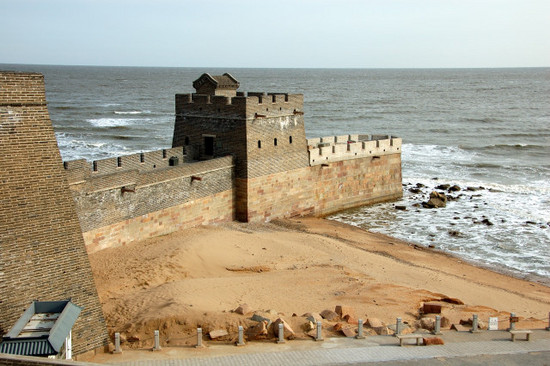Welcome to the adventure of a lifetime! Traveling to China: The Great Wall; Explore the ancient wonders of The Great Wall, an experience that offers a perfect blend of history of one of the world’s most fascinating civilizations and awe-inspiring vista blended with nature, and modernity.
In this itinerary below which is only one possibility, we’ll take you through everything you need to know to make the most of your trip, from the best time to visit to must-see sections to suit your interests, tastes, and budget, and the awe-inspiring experiences it offers to adventurer, and even some FAQs for your convenience.
Unveiling the Great Wall of China
-
History and Significance of the Great Wall
The Great Wall is a symbol of China’s deep-rooted heritage and engineering prowess. Dating back over 2,000 years, with construction over several dynasties to safeguard China against external invasions. It remains an iconic symbol of Chinese civilization and proudly holds the distinguished title of a UNESCO World Heritage site, attracting visitors from across the globe.
Its historical significance as a reminder of the rich history of the Middle Kingdom, which is indeed astounding. Delving into its history adds depth to the experience of exploring this remarkable monument during a visit. Here’s a brief overview of its history and significance:

Chinese Emperor Qin Shui Huang in the ‘Terracotta Army’, made in tribute to this almighty leader.
History of the Great Wall
- Origins: Over 2,000 years ago, in the 7th century BC, the construction of the Great Wall began, people in different parts of China started building the Great Wall. The initial walls were built to protect the land from northern, nomadic invaders.
- First Emperor Qin Shi Huang: The most famous section of the Great Wall was originally conceived by Emperor Qin Shi Huang (221-206 BC) also calledthe First Emperor. Emperor Qin Shi Huang was the creator of the first unified Chinese empire and creating a big wall to protect the country. His dynasty, the Qin Dynasty masterminded the process of connecting a number of earth works (made of hard-packed soil called “rammed earth”) thrown up for protection by different States into a single system to form a continuous protective
- Ming Dynasty Expansion: The most well-preserved sections of the Great Wall, which many tourists visit today, were built inthe 14th through 17th centuries A.D., during the Ming dynasty (1368-1644 AD). The Ming Dynasty extensively rebuilt and strengthened the wall to protect against outside invaders … Mongol and Manchu invasions and an attempt to keep the Chinese in China. The majority of the work took place along the old walls built by the Bei Qi and Bei Wei
Significance of the Great Wall
- Defensive Structure: The main designed purpose was to aid in the defense against invasions, though the Great Wall never effectively prevented invaders from entering China.
- Symbol of Chinese Civilization: The Great Wall is often considered a symbol of China and its enduring civilization and the most common emblem of China for the Western world…it represents the unification of China as a country. Its construction over centuries isa testament to the determination, engineering skill, and the challenges faced by ancient civilizations in defending their borders.
- Cultural and Historical Significance: The Great Wall holds immense cultural and historical significance inancient China cannot be overstated. It has been designated as a UNESCO World Heritage site, and it has been a part of many Chinese legends, folklore, and works of art.
- Tourism and Economic Impact: The Great Wall has become a major tourist attraction, an inspiring wonder among its millionsof visitors each year draws millions from around the world each year. The Great Wall has a wide-ranging impact on tourism, significantly to China’s economy and promotes international cultural exchange.
- Engineering Marvel: The construction of the Great Wall was an astonishing feat of human engineering feat for its time showcasing the prowess of ancient Chinese builders. It involved the use of various materials, including stone, earth, wood, and other materials available in the respective regions, even sticky rice as a binding agent was used. It also employed advanced architectural and defensive techniques while building watchtowers, fortresses, and beacon towers all along its really long path.
- Cultural Exchange: The Great Wall played a vital role in ensuring cultural exchange as well. The Wall was not just a barrier but also to help with the trade route across China and cultural interaction between the Chinese and the various nomadic groups beyond it to exchange ideas and goods.
- Military Significance: as mentioned above the Great Wall was not always effective in preventing invasions, it did made things a bit slower and hinder incursion, providing the Chinese military with some extra time to get ready to respond and defend their territory.
The Great Wall of China continues to stand as a symbol of the Chinese nation to the enduring history and culture. It is still one of the most appealing attractions all around the world for tourists and historians alike to marvel at its grandeur and historical significance.
- Construction of the Great Wall
Construction of the Great Wall continued for over 2,000 years, under the rule of many different dynasties in the 7th century BC. The earliest sections of the Great Wall were built by individual states in different regions like different teams to protect their areas during either Spring& Autumn Periodor Warring State Period, about 7th century BC. In 221 BC, Qin Shi Huang ordered the construction of a single, continuous wall. The wall was much wider and taller than any of the previous walls. The Ming Dynasty (1368-1644) was responsible for maintaining and strengthening the Great Wall that we see today.
The Great Wall served for many centuries its purpose well protecting China from northern invaders, beside playing a huge role in trade and communication. However, by the 19th century, the Great Wall was no longer effective as a military defense, it became one of the most popular tourist destinations in China. The Great Wall is a testament to the engineering and architectural skills of the Chinese people.
Planning a Visit to the Great Wall
If you’re planning a trip to the Great Wall, we’ve got you covered. We’ve got all the info you need! Learn about Choosing the Right Time to Visit, how to get there, what to pack, and essential travel tips for a Great Wall adventure unforgettable wall experience.
Choosing the Right Time to Visit
The Great Wall is enchanting year-round, but like any other place in the world, it has its own unique climate and weather conditions that play a huge factor in determining the ideal time for a visit. The best time to plan your trip during is during spring (specifically from April to June) and autumn (September to early November) since these are the shoulder seasons before and after these months. During these periods, the weather is mild, with comfortable temperatures, less rainfall and the landscapes are adorned with vibrant colors.
Summers can be hot and crowded, while winters can be bitterly cold, which may impact your overall experience making it essential to plan your visit accordingly.
-
Notable Sections of the Great Wall
The Great Wall of China is an awe-inspiring feat of ancient defensive but, some sections stand out to enjoy the best quality among all. Explore famous segments like Badaling, Mutianyu, and Jinshanling, each with its own unique charm and history.
Exploring the Great Wall
Great Wall Sections
The Great Wall is not a single, continuous structure but is composed of various sections and fortifications built during different dynasties. Each section has its unique charm and historical significance. Some of the most popular sections to visit include:
Badaling: This is the most visited section, located just 43 miles northwest of Beijing. It’s a well preserved and easily accessible section with breathtaking views. It’s the go-to choose for many tourists and domestic. Badaling has a cable car for those who prefer a more leisurely visit.
Mutianyu: This section is renowned for its stunning natural scenery and historical significance offering visitors a glimpse of the wall amidst lush, green landscapes. If you prefer a less crowded but equally impressive section, make it an excellent choice for a more peaceful experience than Badaling. Surrounded by lush greenery, rolling hills and picturesque Great Wall adventure.
Jinshanling: is less developed, renowned for its original appearance, with fewer crowds. A paradise for hikers and for those seeking an adventure with varying levels of difficulty. The breathtaking panoramas., rugged terrain and striking views make it a favorite among hikers and photographers.
Simatai: With sections that have been intentionally left unrestored, renowned for its steep gradients and challenging terrain. Simatai is known for its stunning night views, showcases the Great Wall in a completely different light. It offers a mix of the old and the new, with some sections being beautifully preserved while others remain in a state of disrepair.
Huanghuacheng: A tranquil and less crowded section.
Experiencing the Wall
Walking along the Great Wall, you’ll be amazed by the incredible views and architectural grandeur. It’s like stepping in the footsteps of ancient soldiers, treading on the same stones that once patrolled is a profound experience. As you hike the wall, you’ll come across watchtowers, fortresses, and beacon towers, each with its unique historical significance.
Practical Tips for Travelers for a Memorable Visit
How to Get There
Beijing – Your Gateway
Most travelers start their Great Wall adventure from Beijing, China’s capital, it is easily accessible. You can reach the various sections of the wall via several transportation options available. Be sure to book your tour in advance to secure your spot, especially during peak tourist seasons.

What to Bring
- Wear Comfortable Clothing: The terrain can be rugged, so wear comfortable shoes and clothing suited for hiking.
- Dress in Layers; Dressing in layers will help you adjust your clothing according to different types of weather conditions and keep you comfy and healthy.
- Stay Hydrated: Carry plenty of water and snacks, as refreshment options can be limited in remote areas, especially if you are going with kids. Food options can be limited on the Wall.
- Preserve the Heritage: Be respectful of the wall’s historical significance and avoid damaging or defacing it in any way… Leave rocks, plants, and other natural objects as you find them .
- Capture the Moment: Don’t forget your camera; the Great Wall provides the world’s most captivating landscape photography locations.
Hiking Tips
Walking on the Great Wall of China can be challenging, and it is essential to take hiking tips seriously.
- Wear comfortable clothing and sturdy hiking shoes.
- Take frequent breaks and stay hydrated…bring enough water and snacks.
- Be prepared for steep ascents and uneven, and the incline can be strenuous.
General Tips
- There’s a lot of the Great Wall to see, it would be better to choose the section that aligns with your interests, whether it’s history, adventure, or scenery.
- There is no doubt that the Great Wall requires mental and physical endurance, so be prepared for varying degrees of physical exertion; some sections require more stamina than others. Choose a route that matches your experience and fitness level.
- We’ve all heard the saying—there’s no bad weather, only poor clothing. Dress appropriately, all sorts of variables can change while visiting the great wall, considering the weather and the terrain you plan to explore.
Entry Fees
Entry fees vary depending on the time of year you plan to visit and the section you choose to visit. Some sections are free, while others may charge a fee. Prices are reasonable and well worth an enjoyable experience.
Accommodation Choices
luxury hotels, cozy hostels, or an authentic homestay, that offers modern amenities and a convenient location. there are numerous near the Great Wall.
Transport Options
The total length of the Great Wall of China is over 21,000 kilometers. To get to the Great Wall of China sections there are several transfer services which include:
- Public Transportation: Buses and trains are cost-effective and reliable.
- Private Transfers: Convenient for groups and families for those who seek a more flexible schedule.
- Hiking: Explore the wall on foot for an up-close adventure.
Guided Tours
What are the benefits of booking a tour guide? Consider booking a guided tour who can provide valuable insights information such as unexplored streets, corners, food joints, and architectural structures. Local guides provide historical context and hidden gems.

The magnificence of the Great Wall of China today, via Fodors Travel
The Great Wall Today:
Today, the Great Wall has no military function, but is a great ancient engineering work, although many sections of the Great Wall was been damaged and disappeared due to its long history, natural disasters and human activities it became the witness that tells us the rise and fall of Chinese history.
Exploring the Most Popular Great Wall FAQs
Q: Can I walk the entire length of the Great Wall? A: Walking the entire length is not possible, but you can explore various sections. as it spans over 13,000 miles and is often broken into separate sections. You can walk on specific sections that are open to tourists.
The wall is designed like a big dragon circling the mountains (10,000 Li = 5,000 km)
Q: Is it safe to travel to the Great Wall? A: Yes, in general, it is safe to travel to the Great Wall. However, the well-preserved sections open to tourists are safe, and there are designated paths and areas for visitors. However, like any tourist destination, it’s essential to follow safety guidelines and take standard safety precautions.
Q: Are there entry fees? A: Yes, there are usually entry fees vary by different sections of the Great Wall. Be prepared to pay for access. It’s advisable to check the specific entrance fees for the section you plan to explore.

Some sections of the Great Wall, such as Badaling and Mutianyu, there are cable cars or chairlifts.
Q: Can I take the cable car up the wall? A: Yes, at some sections of the Great Wall, such as Badaling and Mutianyu, there are cable cars or chairlifts for a convenient ascent and time-saving that can take you up to the Wall, to access certain sections.
Q: Are there hiking opportunities on the Great Wall? A: Yes, the Great Wall is a hike of a lifetime, many sections offer hiking opportunities. Some parts have well-maintained paths, while others are more challenging and less maintained like Jiankou, Simatai, and Jinshanling. Be prepared for different levels of difficulty.
Q: Is there food and water available on the Great Wall? A: Some sections have food stalls or restaurants, but it’s a good idea to bring your water and snacks. If you plan on hiking, some hikes can be 2-3 hours and keeping hydrated is essential.
Q: Can I visit the Great Wall in winter? A: Yes, you can visit the Great Wall in winter, but be prepared for cold temperatures. Some sections may have reduced visitor facilities during the winter months, and the possibility os closures may be due to snow or ice. So it’s a good idea to Check the weather and plan accordingly.
Conclusion
Traveling to China: The Great Wall of China is not just a national treasure but a global wonder that promises unforgettable memories. Its historical, architectural, cultural significance and an adventure through breathtaking landscapes makes it a must-visit destination that appeals to a wide range of interests. Embark on your journey and be captivated by the grandeur of this timeless marvel. Plan your trip wisely, on an unforgettable expedition to one of the world’s rich culture and heritage of China’s iconic Great Wall. It is a journey through the annals of human history.
Krak des Chevaliers is one of the best-preserved Crusader castles
 The Great Wall at Shanhaiguan the far Eastern End where it meets the sea at Bohai Bay.
The Great Wall at Shanhaiguan the far Eastern End where it meets the sea at Bohai Bay.
See China’s Iconic Great Wall From Above
WALKING THE GREAT WALL IN WINTER
Believe it or not:
- It is said that Gog and Magog are buried beneath it, and they will be emerged one day.
- The Great Wall of China is the only man-made object visible from the traveling space or from the moon with the naked eye.
 Al-Idrisi’s World Map with Gog and Magog behind the wall and circled in red.
Al-Idrisi’s World Map with Gog and Magog behind the wall and circled in red.
Note, this map is oriented to the south so here Gog and Magog are in the proximity of China.
Hotels in the region:
Check availability, maps, photos and reviews before traveling, and book at the guaranteed lowest price.











































